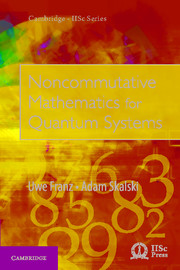2 - Quantum Dynamical Systems from the Point of View of Noncommutative Mathematics
Published online by Cambridge University Press: 18 December 2015
Summary
A starting point of ‘noncommutative mathematics’ is based on the observation that many features of classical spaces can be phrased in terms of the algebras of functions defined on these spaces. In these lectures we will present a few examples of how in presence of dynamics this idea leads to the study of ‘quantum’ transformations. Our focus will be on two building blocks of modern abstract theory of dynamical systems: entropy and ergodic theorems.
Noncommutative Mathematics and Quantum/ Noncommutative Dynamical Systems
The notion of quantum processes, or quantum dynamical systems, can be understood in several different ways, as can be viewed for example by looking at some of the several hundred articles classified in the MathSciNet database under the heading MSC 46L53 (corresponding to ‘Noncommutative dynamical systems’). In these lectures we will present a purely mathematically motivated approach to certain ‘quantum’ or ‘noncommutative’ versions of fundamental concepts and problems studied in classical topological and measurable dynamics. The origins of the need to study questions of that type can be naturally found in quantum mechanics: readers interested in physical interpretations of the topics studied below can consult, for example, the book [AF], or the lecture of Uwe Franz in the first part of this volume. Here our approach will be based on what is nowadays often called the philosophy of ‘Noncommutative Mathematics’.
Notational conventions
For a subset X of a Banach space the closed linear span of X will be denoted by (and the usual linear span by Lin X). Notation F ⊂⊂ Z will be used to signify that F is a finite subset of Z. Sometimes we will write for. All vector spaces (algebras, Hilbert spaces, and so on) will be considered over ℂ. As in the first part of this volume, scalar products are linear on the right (and not on the wrong!) side.
Noncommutative Mathematics – Gelfand–Naimark Theorem
Definition 2.1.1 A Banach algebra A with involution (that is, a complex algebra with involutive antilinear antimultiplicative map * : A → A, equipped with a submultiplicative norm making A a Banach space and such that the involution is an isometry) is called a C*-algebra if
‖ a*a‖ = ‖a2‖, a ∊ A.
For proofs of various general statements related to C*-algebras that will be used below we refer, for example, to the monograph [Mu].
- Type
- Chapter
- Information
- Noncommutative Mathematics for Quantum Systems , pp. 121 - 172Publisher: Cambridge University PressPrint publication year: 2016

